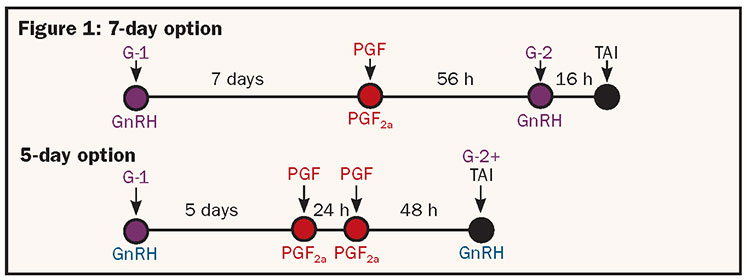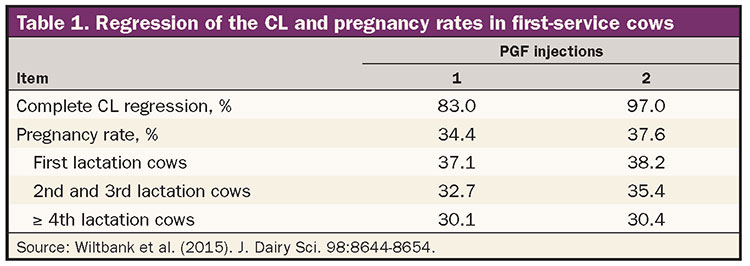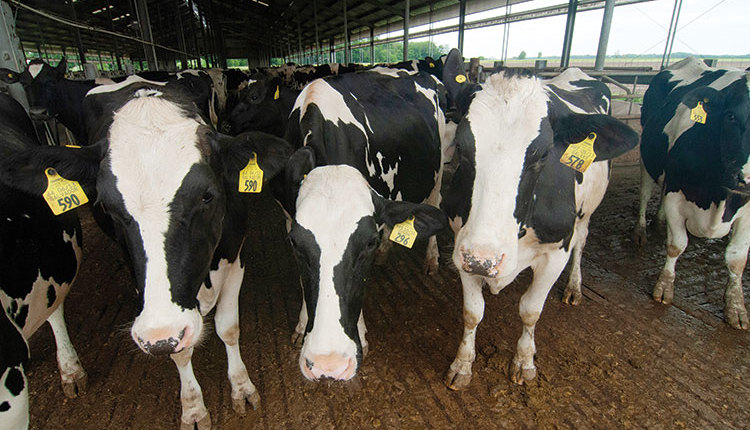The author is a professor of animal sciences at Kansas State University, Manhattan.
Since the early 1970s, we have had a magical drug that has benefited dairy cow breeding programs — prostaglandin F2α (PGF). First isolated from marine corals and later synthetically produced in the laboratory, PGF has been a key product to help induce estrus in cows and heifers to facilitate A.I. breeding.
In its early days of use, and because of its scarcity, it was infused into the uterus to demonstrate its ability to lyse or “kill” the corpus luteum (CL) at a dose of just 5 mg. Today, we use a dose five times larger when administering PGF into muscle tissue. Since the original PGF, the analog clones require lesser effective doses to lyse the CL.
Today’s timed A.I. breeding programs require two effective products to synchronize the estrous cycle and time of ovulation. Both gonadotropin-releasing hormone (GnRH marketed as Cystorelin, Factrel, Ovalyse, Fertagyl, or GONAbreed) and PGF (marketed as Lutalyse, Lutalyse HighCon, Estrumate, EstroPLAN, ProstaMate, or Receptal) are critical components to a successful timed A.I. program.
Recent studies examining the limitations to the success of these programs have focused on the effectiveness of administering PGF to cause the CL to regress before A.I. breeding. Although heat activity is not always observed or detectable after PGF during the week of timed A.I., successful regression of the CL to cause progesterone concentrations to become baseline is critical to maximize fertility in lactating dairy cows and replacement heifers.
Five-day timed A.I. programs
A shorter ovsynch program (five days) was developed in beef cattle and later tested in dairy cows. Reducing the program from seven to five days is problematic because in those cows in which GnRH (G-1) induces ovulation and produces a new CL, that new CL is only three or four days old when PGF is administered. Therefore, when employing a five-day program, a second dose of PGF is necessary to ensure the new, young CL regresses before insemination.
Advantages of the five-day over the seven-day program suggest that the follicle, which develops after ovulation in response to G-1, would be younger and healthier and produce a more fertile egg. Although likely true, the ovulatory response to G-1 is less than 50 percent in open cows resynchronized after a not-pregnant diagnosis. Thus, less than half of the treated cows may realize this advantage.

Early comparisons of the five- and seven-day programs were improperly done because what was tested is shown in Figure 1. The potential advantage for the seven-day program with a second dose of PGF was not tested, so the improved fertility associated with the five-day program was attributed to factors other than greater regression of the CL in more cows.

CL regression in first-service
Recent studies have now demonstrated that CL regression in seven-day programs is improved when two doses of PGF are administered 24 hours apart, the first of which is administered approximately 72 hours before timed A.I. A large multi-herd study was conducted in lactating cows before first service to compare one versus two doses of PGF (see Figure 2) in a timed A.I. program. As shown in Table 1, CL regression was improved from 83 to 97 percent, but pregnancy rate only rose slightly from 34.4 to 37.6 percent . . . all of which was manifested inexplicably in second- and third-lactation cows.

CL regression in resynch
A second study was conducted in dairy cows diagnosed open at pregnancy checks and subsequently treated with a five- or seven-day programs that included a progesterone insert at the time of G-1. Three treatments were tested: seven-day program with one versus two doses of PGF compared with a five-day program with two doses of PGF. Cows received the second dose of PGF 24 hours after the first dose.
All cows were administered G-2 at 56 hours after the first or only PGF dose and then inseminated 16 hours later. Blood samples revealed that progesterone did not differ among treatments at G-1, at PGF, or at 56 hours after the first or only PGF dose.
In contrast, overall pregnancy rates improved in cows receiving two doses of PGF compared with cows receiving one dose, regardless of the duration of treatment program (Table 2). No differences in pregnancy rates occurred in cows starting the timed A.I. programs with a CL.

The difference in pregnancy rates, however, occurred in 28 percent of cows having no CL at the onset of treatments. These are cows that likely ovulated in response to G-1 and had a new, younger CL requiring a second dose of PGF for complete CL regression. In these no-CL cows, pregnancy rates were 30 percent after one dose of PGF compared with 45 percent after two doses.
In cows receiving their first service, CL regression was improved by administering two doses of PGF but pregnancy rate was only marginally enhanced by 3 percentage points. In resynch cows (also treated with a progesterone insert), pregnancy rate was improved when two doses of PGF were administered, regardless of program duration. The real improvement occurred in cows having no CL at the start of the resynch program.
Pencil out for yourself what you think may be the advantage of applying a second dose of PGF in your herd. Happy A.I. breeding!










